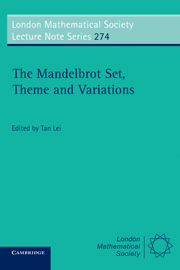Book contents
- Frontmatter
- Contents
- Introduction
- Preface
- The Mandelbrot set is universal
- Baby Mandelbrot sets are born in cauliflowers
- Modulation dans l'ensemble de Mandelbrot
- Local connectivity of Julia sets: expository lectures
- Holomorphic motions and puzzles (following M. Shishikura)
- Local properties of the Mandelbrot set at parabolic points
- Convergence of rational rays in parameter spaces
- Bounded recurrence of critical points and Jakobson's Theorem
- The Herman-Światek Theorems with applications
- Perturbation d'une fonction linéarisable
- Indice holomorphe et multiplicateur
- An alternative proof of Mañé's theorem on non-expanding Julia sets
- Geometry and dimension of Julia sets
- On a theorem of M. Rees for the matings of polynomials
- Le théorème d'intégrabilité des structures presque complexes
- Bifurcation of parabolic fixed points
- References
On a theorem of M. Rees for the matings of polynomials
Published online by Cambridge University Press: 05 August 2011
- Frontmatter
- Contents
- Introduction
- Preface
- The Mandelbrot set is universal
- Baby Mandelbrot sets are born in cauliflowers
- Modulation dans l'ensemble de Mandelbrot
- Local connectivity of Julia sets: expository lectures
- Holomorphic motions and puzzles (following M. Shishikura)
- Local properties of the Mandelbrot set at parabolic points
- Convergence of rational rays in parameter spaces
- Bounded recurrence of critical points and Jakobson's Theorem
- The Herman-Światek Theorems with applications
- Perturbation d'une fonction linéarisable
- Indice holomorphe et multiplicateur
- An alternative proof of Mañé's theorem on non-expanding Julia sets
- Geometry and dimension of Julia sets
- On a theorem of M. Rees for the matings of polynomials
- Le théorème d'intégrabilité des structures presque complexes
- Bifurcation of parabolic fixed points
- References
Summary
Abstract
We show the following theorem of M. Rees: if the formal mating of two postcritically finite polynomials is (weakly) equivalent to a rational map, then the topological mating is conjugate to the rational map.
The dynamics of complex polynomials has been extensively studied and many results are obtained. For example, a polynomial of Thurston's type admits a description of the dynamics in terms of external angles, etc (see [DH1]). However, much less is known for rational maps in general (see [R] for degree two case). The mating is a way to construct a rational map or a branched covering of S2 from a pair of polynomials with connected Julia sets. When this is possible, we can understand the dynamics of the rational map in terms of that of the polynomials. The notion of the mating was also introduced by Douady and Hubbard [D].
There are two notions of the mating —the formal mating and the topological mating. In fact there is another, the degenerate mating, which is a slightly modified version of the formal mating. To define the formal mating, we take two copies of ℂ each with the circle at infinity and make a topological sphere by gluing the copies together along the circles at infinity. Then define a mapping on the sphere using one polynomial on one copy and the other polynomial on the other copy.
- Type
- Chapter
- Information
- The Mandelbrot Set, Theme and Variations , pp. 289 - 306Publisher: Cambridge University PressPrint publication year: 2000
- 23
- Cited by



